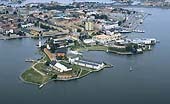This file photo shows Bangladesh Navy's only bleeding-edge
frigate "Bangabandhu". The ship was purchased from South Korea in
2001 but has remained decommissioned for over five years.
The state of the art frigate of the Bangladesh Navy, purchased in 2001 for Tk 500 crore, has remained idle for more than five years now because of sheer 'political meanness' of the immediate past BNP-led alliance government.
Equipped for underwater, surface and air operations, the high-tech frigate, 'Bangabandhu', was decommissioned on February 13, 2002 and removed from the naval fleet, competent defence sources said.
The decommissioning was done on the pretext of corruption in purchasing the frigate. "If there was corruption, let there be legal actions against that. But what is the justification of decommissioning a world class frigate of the navy?" asks a defence high official.
The decommissioning has caused an incalculable loss, as the one-year warranty period of the onboard high-tech equipment elapsed without utilising them.
Meanwhile, at least 300 officers and soldiers, who could have been given a world-class training on the frigate, had to go abroad for the same purpose.
"Above all, the incident had dampened the spirit and energy of the Bangladesh Navy," said a senior defence official.
The caretaker government is now considering re-commissioning the frigate in mid-June.
The procurement of the frigate of model DW 2000H built by South Korean Daewoo Shipyard, triggered controversies prompting the BNP-led alliance government to file an anti-corruption case against ex-prime minister of the last Awami League government, Sheikh Hasina.
The then Bureau of Anti-corruption filed a case in 2003 in connection with the purchase of the frigate from the fourth lowest bidder in the tender Daewoo -- for incurring a loss for the government. The case virtually died after Hasina, Daewoo's local representative Abdul Awal Mintoo, and four defence officers had been granted bail in August 2003.
But while the BNP-led government did not pursue the case, it chose to decommission the frigate in early 2002 on grounds of corruption and sub-standard equipment.
A high powered investigation committee headed by the erstwhile commodore Hasan Ali Khan was formed. The other members of the committee were Commodore Kalimullah, Captain PK Barua and Captain Naser. The committee was assigned to detect substandard equipment installed in the frigate, but it failed to substantiate the allegation.
A defence high official pointed out that the then prime minister Khaleda Zia's personal secretary who is also her nephew, Saiful Islam Duke, and some enthusiastic naval officers, seeking the political clout of BNP, spearheaded the move to decommission the frigate.
Duke resigned from the navy soon after the Awami League government took over power in 1996. "He did so, because he had piles of negative reports on him from the past. He was a disgruntled officer with discipline problems," said the defence official. Duke himself was also involved in various naval purchases between 2002 and 2006, many of which are very controversial.
THE FRIGATE
With the mandate to provide security and surveillance in a maritime area of 40,000 square kilometres, the Bangladesh Navy has been in dire need of a modern frigate since the early nineties as its existing vessels and weaponry became antiquated. The decision to purchase a frigate was taken in 1996 to upgrade the naval operation capacity from a mere surface level to underwater-surface-air level. Daewoo's DW 200H frigate was picked as the best choice because it offered most modern weapons and warfare technology, sources said.
Daewoo completed manufacturing the frigate and handed it over to the navy on May 29, 2001. The then prime minister Sheikh Hasina commissioned it on June 20, 2001 and the frigate was in operation for eight months.
"During the only eight months of operation, the equipment and weapon set-up underwent fine tuning to make the frigate fault free. But after the decommissioning, we could do nothing. Now with the warranty period over, we will have to purchase everything that needs replacement," said a defence official.
A frigate's normal life span is of 25 to 30 years. This one already lost five years of its life without being utilised at all.
"The frigate is equipped with torpedo for underwater, missiles for surface, and anti-aircraft guns and missiles for air warfare. This gives us a three dimensional capability. This is a very high-tech ship which could provide world class training for our men. The engine and equipment are among the world's best that money can buy," he added.
"This frigate was not over priced," he pointed out.
The 340-metre long and 41-metre wide frigate also has a helicopter base on board. "We will need to buy a helicopter to complete equipping the frigate for three dimensional operations," the official noted. Such a helicopter costs around Tk 5 crore.







